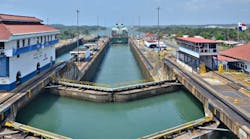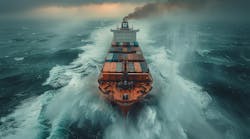Will the Supply Chain Suffer Due to the Panama Canal Traffic Jam?
Drought conditions in the Panama Canal are challenging supply chains that rely on this important waterway to rethink their strategies to move product as shallower-than-usual waters have reduced the number of vessels allowed to traverse the canal per day and restricted maximum ship weights. It’s coming at a cost of both time and money.
Because the tonnage is restricted, some companies have had to offload cargo, specifically containers. “They unload some of those containers and put them on trucks or they’ll move them across or put them on the railroad,” says Andrew Thomas, associate professor, marketing and international business, The University of Akron and author of “The Canal of Panama and Globalization: Growth and Challenges in the 21st Century.”
“Of course, unloading from a ship and putting it onto a train or putting onto a truck and then driving it or railing it across 50 miles of Panama and then picking it up on the other side and putting it back on that same ship as it goes into the ocean on the other side -- time and money. And oftentimes they don't wait for those shipments to happen. So they might have to wait for another vessel. That container might have to sit for a week or two,” he says.
The Panama Canal Authority has reduced the number of vessels that can pass through the canal per day from 36 to 32; media outlets are reporting wait times have reached up to three weeks and some are reporting a backlog of over 200 ships.
Companies are seemingly facing a lose-lose situation. If they decide their vessel should continue to traverse the canal, they face extended wait times due to the pileup; similarly, companies that decide to find an alternative route face extended shipping times.
A Crucial Waterway
The Panama Canal has long been crucial to global trade and international supply chains. According to Reuters, “More than 14,000 ships crossed the canal in 2022. Container ships are the most common users of the Panama Canal and transport more than 40% of consumer goods traded between Northeast Asia and the U.S. East Coast.”
“It’s all run by fresh water. That’s the unique thing about the Panama Canal, they don’t use the ocean water to raise and lower the ships in the locks. They use fresh water, which of course comes from rain,” says Thomas.
When the canal was first built in the early 1900s, the locks were constructed for ships of a particular size. What has been pivotal to the importance of the canal today was the expansion of the waterway, says Thomas.
“The Panamanians in 2006 had a national referendum, and they said, ‘We're going to come up with the money as a nation, probably, 2 or 3 or $4 billion,’ which is a lot for a country of 4 million people. ‘We're going to raise the money, and we're going to do this. We are going to build a whole other set of locks, it's going to be able to handle these massive container ships… and that'll make the canal more valuable to more countries, to more companies, to more international shippers, particularly with all the traffic that's coming out of China.’ So that was that was their objective. And they did it,” says Thomas.
Although the initial intention was to expand the canal for container ships, authorities discovered a new use for the freshly expanded Panama Canal.
“These huge liquid natural gas ships are able to traverse the canal from the eastern United States and go to China, India, Korea, Japan. So the Panama Canal is becoming much more important for more countries of the world than ever before,” Thomas says. “When there’s challenges in the canal, the global impact has a massive reach because it’s not just simply some shipments coming from Chinese consumer goods manufacturers to the east coast of the United States, it’s now critical energy to heat homes and operate businesses that’s going from the United States to the biggest energy importers in the world.”
The canal is now one of the primary sources for energy shipments for several countries, Thomas says.
Short and Long-Term Impacts
The University of Akron professor says consumer goods is arguably the industry that will be affected the most due to the current weight restrictions on container vessels that account for a huge amount of international trade. Although one of the canal’s most important jobs is hosting LNG ships, don’t worry about an immediate energy crisis.
However, companies are keeping a close eye on the canal’s situation. “Their ears are popping up. And they're like, ‘Well, we’ve got to be paying attention to what's going on there,’” Thomas says.
The potential supply chain repercussions are also largely dependent on what the coming weeks and months hold.
Thomas mentions that Panama has been getting rain and storms in the past few weeks, possibly signaling that the wet season has just been delayed with a late start to rainfall. “We might get to September, October, and the canal will be operating fine with plenty of fresh water because of the rainy season coming.”
The bigger issue, one that is only exacerbated by the drought, is the country’s water management, Thomas says. Offloading and restricting the number and weight of vessels are mere temporary fixes for this overarching problem.
Along with using water for things like consumption, agriculture, technology and waste, Panama relies extensively on hydropower. With this reliance on water for many critical components of the country’s economy, Thomas says there needs to be a better emphasis on water conservation.
“It takes time because that's cultural, that's societal, that's political. It's much more nuanced. And you can't snap your fingers and just simply say, ‘Okay, everybody's going to do better with water.’ It doesn't quite work that way.”
Thomas sees better water management as the long-term solution to issues caused by drought. Although there will be years where there will be less rain than desired, the subsequent problems can be alleviated with stored and conserved water, he says.
“The shippers will pay the initial cost, and the consumers will ultimately, they always do, will have to pay whatever the extra costs are for this. But you could be reading this story next year, and the year after, and the year after that for many years to come” until they have proper water conservation techniques.
As for the canal’s prospects, Thomas has a positive outlook; over time, he sees Panama adapting to effective water conservation efforts, optimizing the canal for future conditions.
“I think the bigger view, longer term is that the canal is in good shape. It's in good hands,” he says. “I think the things that will ultimately determine the future of the canal and its role in the supply chain are much more market driven.”




